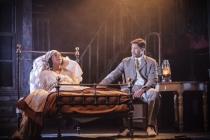The El Train – Hoxton Hall, until 30 December 2013
Sometimes the venue is everything when it comes to theatre. It is hard to imagine watching Eugene O’Neill’s three short plays – that make up The El Train – about life in the Bronx from the comfort of plush velvet seats  on Shaftesbury Avenue. Yet sat on rickety wooden seats in the cold, draughty Hoxton Hall, hemmed in by the elbows of your neighbours, and in the heart of what was once the heart of the East End slums, O’Neill’s histrionic melodramas about the perils affecting life among the forgotten beings to make a kind of sense.
on Shaftesbury Avenue. Yet sat on rickety wooden seats in the cold, draughty Hoxton Hall, hemmed in by the elbows of your neighbours, and in the heart of what was once the heart of the East End slums, O’Neill’s histrionic melodramas about the perils affecting life among the forgotten beings to make a kind of sense.
The atmospheric surroundings of Hoxton Hall is critical in making the whole concept of The El Train work at all. Outside in Hoxton and around Old Street – Britain’s ‘Silicon Roundabout’ – it is difficult to appreciate just what life would have been like for those living in the same streets a century before, and so the location helps to ease the audience back to a time when earnest members of the Fabian society would deliver lectures on a range of esoteric subjects because they truly believed in the moral purpose of education for the bettering of the life of the working man; indeed it comes as little surprise to discover that for over twenty years the venue was run by the Quakers and linked to the temperance movement.
The El Train is a good way of seeing O’Neill writing in the style that would see him win two Pulitzer prizes and become Nobel laureate. A passionate writer that does for the American poor what had previously been highlighted in the U.K through works by George Bernard Shaw and Charles Dickens, O’Neill can be exhausting in the long form but in 20 minutes bursts his style can be rather invigorating.
O’Neill tends to be venerated by theatre critics but in his full-length plays he is often to be endured as much as enjoyed. He is as melodramatic as Tennessee Williams but without the entertaining southern gothic that makes Baby Doll and The Glass Menagerie such lurid delights. His plays, like Long Day’s Journey Into Night, mark some of the first developments of the narratives that are now seen as the great American themes and which dominate American drama and literature to the present day. However O’Neill’s work seems to lack the stringent naturalism that propels Arthur Miller’s All My Sons and Death of a Salesman into the ranks of great drama.
 However in the short-form of The El Train one is reminded that there is nothing inherently wrong with melodrama as a dramatic style but it is in the application that it often falls apart. Placed in the hands of strong actors, who commit wholeheartedly to the concept rather than act against it, the moral force of the work begins to shine through. And Ruth Wilson, after her turns in Anna Christie and A Streetcar Named Desire at the Donmar Warehouse, has proved herself a very fine actor indeed.
However in the short-form of The El Train one is reminded that there is nothing inherently wrong with melodrama as a dramatic style but it is in the application that it often falls apart. Placed in the hands of strong actors, who commit wholeheartedly to the concept rather than act against it, the moral force of the work begins to shine through. And Ruth Wilson, after her turns in Anna Christie and A Streetcar Named Desire at the Donmar Warehouse, has proved herself a very fine actor indeed.
Wilson is a magnificent presence in the first piece; a monologue about a frustrated housewife and her alcoholic artistic husband, and which is by some margin the strongest of the three. She captures the very essence of a human teetering on the edge, struggling to free herself from the binds placed on her by both her husband and her own sense of pride.
The real skill of Wilson’s performance is how she understands the limitations of O’Neil’s writing to a modern audience. She doesn’t try to force the language but instead inhabits the whole character; Wilson brings the part alive with a nervous tension that can be read through the way her hands struggle to knot the front of her apron or pick at the wood chipping off the kitchen table. The weight of the burden upon her can be felt through the way that the corner of her mouth begins to pull down as she lists her husband’s various failings, and in the rigidity of her body every time her husband makes noise offstage.

Nice post and blog.
If there is any chance you like films from around the world from any period please check out my blog. http://aworldoffilm.com/
Thanks, glad you enjoyed it and hope you stick around for more.
I like the look and feel of your blog. I am a big fan of classic films also – but one has only got time to write so many blogs! If you are interested perhaps I can write a feature for your site in 2014 – I write quite a lot about Shakespeare and there are a couple which probably fall under the ‘classic film’ banner (perhaps something like Kurosawa’s Ran or Throne of Blood?)
That sounds amazing. Yes that would be great. Thank you. And yes I will keep looking out for your blog.